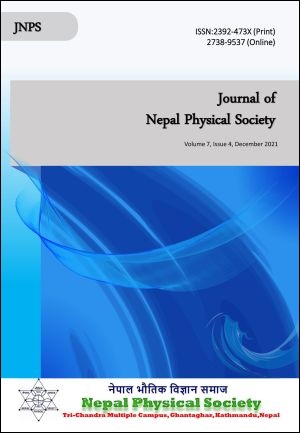A Detailed Morphological and Spectroscopic Study of Merging Dwarf Galaxy PGC 030133
DOI:
https://doi.org/10.3126/jnphyssoc.v7i4.42928Keywords:
Compact dwarf galaxy, Galaxy merger, Half-light radius, Hα line, Star Formation RateAbstract
We present a detailed morphology and spectroscopic study of a merging dwarf galaxy PGC 030133. Using the publicly available fiber spectroscopic data from the Sloan Digital Sky Survey (SDSS), we analyzed nine-strong emission lines of wavelength range 4336 Å to 6739 Å. We find that the strongest emission line is OIII5007, with an intensity of 146.32 × 10-17 erg/s/cm2 /Å. The observed emission lines are well fitted with a Gaussian profile with a coefficient of regression greater than 96%, and the derived full-width half maximum (FWHM) is less than 4.2Å. The Balmer decrement, characterized by the line ratio between Hα and Hβ is 3.07, suggesting a presence of dust at the center of PGC 030133. We derived the star-formation rate and emission line metallicity of PGC 030133 using extinction corrected emission line fluxes. SFR derived from Hα emission line flux is 0.0033 Mʘyear-1 and emission line metallicity derived from flux ratio between NII and Hα is 8.13 dex. Using the SDSS, g, and z-band imaging data, we derived morphological parameters. PGC 030133 has a half-light radius of 3.38 arc second and 3.05 arc second in g-band and z-band respectively and observed one-dimensional light profile is well fitted with a Sersic function with near exponential Sersic index ~ 0.9.
Downloads
Downloads
Published
How to Cite
Issue
Section
License
All right reserved. No part of this Journal may be reproduced in any form or by any electronic or mechanical means, including information storage and retrieval system, without permission in writing from the publisher, except by a reviewer who may quote brief passage in a review. The views and interpretation in this journal are those of author(s) and they are not attributable to the NPS.




